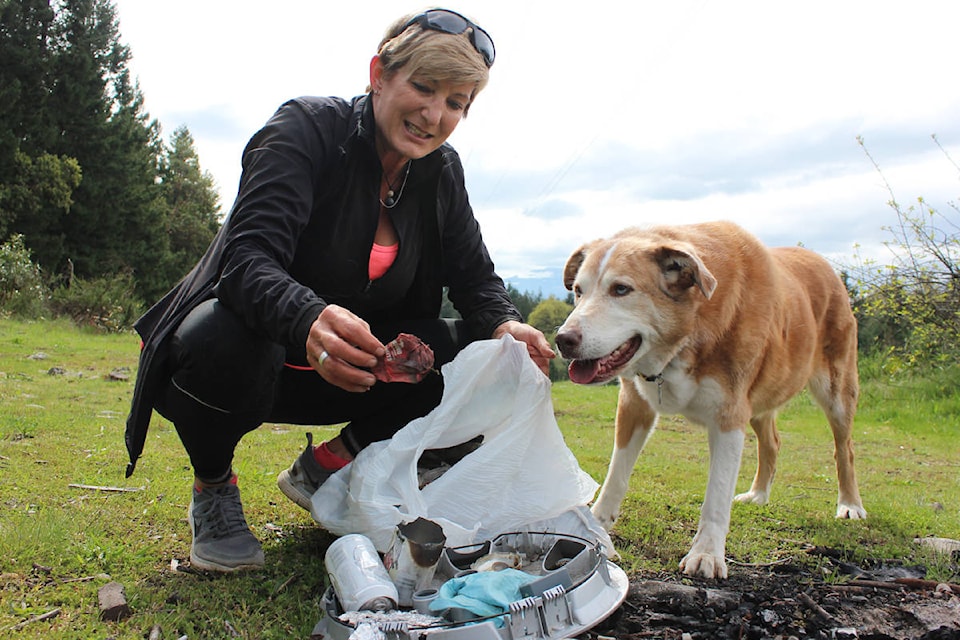Nearly every day for the last two years, Jani Drew has been jogging and picking up trash around the Nanaimo River and elsewhere.
“This is my backyard. This is where I live. This is the natural area and I can just walk and come here and yet look at all the trash,” Drew said while pointing to a small heap of discarded junk.
Drew is part of a growing number of people around the world participating in plogging, a relatively new Swedish eco-fitness trend. Created by Stockholm resident Erik Ahlström in 2016, plogging or plogga, as it is called in Sweden, is an activity where individuals or groups of people collect litter while jogging or walking, often performing exercises at the same time.
The practice is meant to help change the negative attitudes about cleaning up garbage and transform people into “proud little pickers” said Ahlström in an e-mail to News Bulletin. Ahlström, who founded a non-profit organization dedicated to plogging, explained that ploggers typically burn more calories because they are performing exercises such as squatting or lunging all while jogging or walking and carrying the added weight of the garbage they’ve collected.
“Half an hour of plogging will burn 288 calories on average,” he said.
Although plogging began with joggers, it is not limited to runners and picking up litter has been combined with other outdoor activities such as biking, hiking, geocaching and even paddleboarding.
The trend has since caught on in other parts of the world – including Europe and the United States – as well as on social media, where Drew often shares photos of her plogging hauls. She also created a Facebook group called Plogging B.C. that has just under 100 members.
“What appeals to me about plogging is that I can make no special effort. I don’t have to join an organization. I can take pride in my area and keep it clean,” Drew said.
READ ALSO: Nanaimo partners with groups looking to keep the city clean
Drew says she began plogging two years ago after she became annoyed with the amount of garbage around Mount Benson.
“I used to think ‘oh my God I hate this. I just hate this. Somebody should do something about this’ and I literally stopped in my tracks and thought ‘I am somebody’ and since then it has literally been bags and bags of garbage,” she said.
Since then, Drew has been plogging on almost a daily basis, collecting two or more bags of trash each time. Most of the items are single-use, usually from fast-food restaurants and often made of plastic.
“People grabbing a snack or beer, and so they don’t want it in their way so they just chuck and don’t think about it,” she said.
Whether it’s coffee cups or coffee lids, beer cans, liquor bottles, bongs, chemical containers, appliances, car parts, machinery, food, clothing or ammo cartridges, Drew says she has come across just about everything imaginable – as well as the unimaginable – while plogging.
“I’ve found about 12 needles, methadone prescription and a rubber band and a rolled up $50 bill. To me, that told a story, potential drugs and a potential sale,” Drew said, adding that she’s also found adult toys, divorce orders, dirty diapers and nude photos of people.
Drew says the amount of garbage she collects dramatically increases in the summer months when significantly more people venture down to the river. While there is a garbage can near one of the gates along the Nanaimo River, Drew says it is hardly used and believes it actually encourages people to dump their garbage along the river bank.
“Some stuff goes in the bin, but people think of it as a dump. People think they can just come here and bring external garbage and dump it,” she said.
Despite the seemingly endless amount of litter around the river, Drew feels she is making a difference in a “very micro” way. She believes increased education and public awareness about “basic environmental concepts” can, and will, make a big impact over time.
“We have to be reactive. We have to see it, and whether we like it or not, pick it up. If we all picked up trash, it would make a difference,” she said. “If we all just do small efforts like this, we can make a difference. I cleaned up a five-kilometre area around my own and it is noticeable.”
